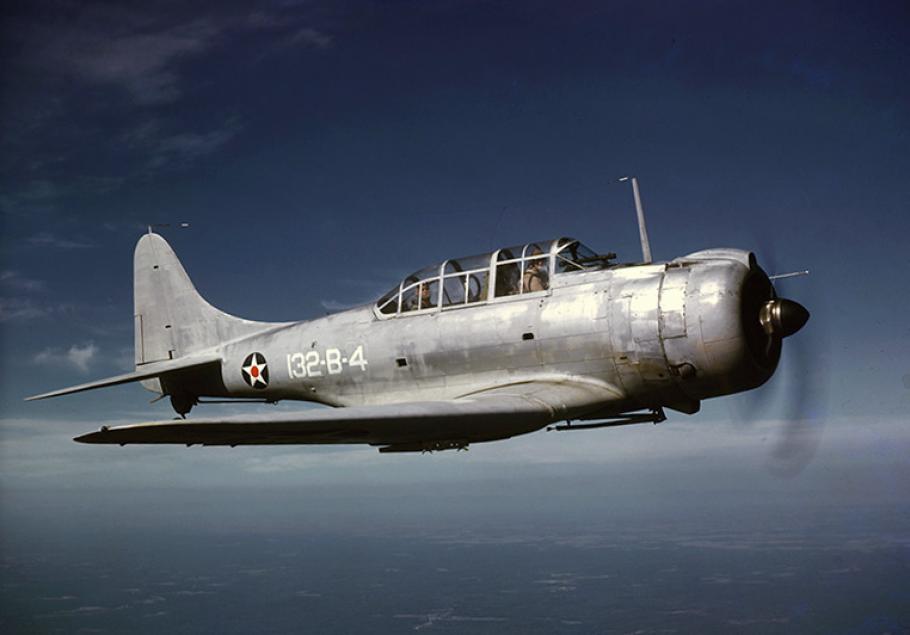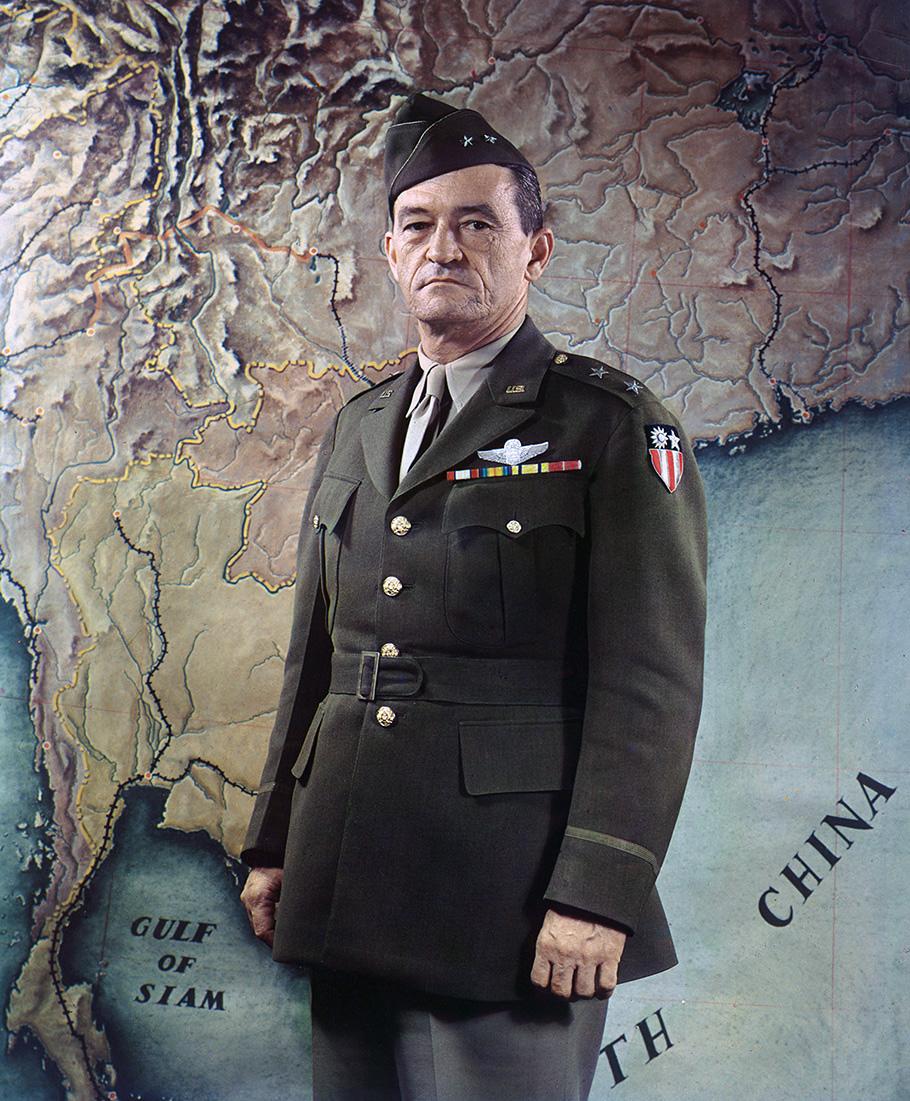A new gallery examines how the wartime revolution in technology redefined the promise and peril of military aviation—and transformed America’s place in the world.
World War II is a daunting topic for museums to address, if for no other reason than the sheer scope and scale of the conflict. The National Air and Space Museum’s collection of the war’s objects runs somewhere around 10,000 artifacts, ranging from lapel pins to four-engine bombers. The vastness of the collection makes the process of choosing what goes in the Jay I. Kislak World War II in the Air gallery (which measures just under 6,000 square feet) a delicate balancing act as the Museum continues to reimagine its exhibits. The reshaping of this gallery presents a long-sought opportunity to better orient the Museum’s World War II content to new generations of visitors.
The Douglas SBD Dauntless was one of the truly great aircraft of World War II. During the Battle of Midway, SBDs destroyed four Japanese carriers, a stunning breakthrough for U.S. naval forces.
When the Museum’s original World War II gallery opened in 1976, the war was within the lived experience of nearly half the exhibition’s visitors. Even for those born later, popular culture of the time featured frequent representations of the conflict—and the air war in particular—with television shows like “Baa Baa Black Sheep” airing in primetime and Battle of Britain in heavy rotation for movies of the week. Such popular culture shaped my own interest and career in both history and aviation from a young age. Despite its profound effect on global, military, and cultural affairs, the passage of time has softened awareness of the conflict for subsequent generations. Even though many Americans still see the war as central to their national identity—solidifying the United States’ place in the world as a global leader and emergent superpower—the story of how aviation came to define the conflict is hazy for many present-day visitors. For that reason, the new gallery sets out to frame the war in an accessible way, with aviation in the foreground.
For those who enjoyed the original gallery’s lineup of five fighter aircraft and the forward fuselage of the Martin B-26 Flak-Bait, the new exhibit features some old favorites, including the return of the North American P-51D Mustang and the German Messerschmitt Bf 109G. Familiar artifacts moved from other galleries include the Eastern Division FM-1 (F4F) Wildcat, the Douglas SBD-6 Dauntless, and the V-1 “buzz bomb.” New aircraft going on display include the Soviet Ilyushin Il-2M (one of only a handful of survivors of the war’s most-produced combat aircraft), the Japanese Kugisho MXY7 Ohka 22, and a Douglas C-47 nose section. The old exhibition’s signature backdrop, artist Keith Ferris’ Fortresses Under Fire, depicting the 303rd Bomb Group, also makes a return after extensive conservation.
Lieutenant Clifford Allen of Chicago, Illinois, stands in front of a C-47 preparing to drop the 555th Parachute Infantry Battalion, the only African-American parachute unit.
The new gallery seeks to better frame the story of World War II around the idea that aviation was central to victory, and the exhibition will highlight key areas of wartime aeronautical innovation that changed the nature and experience of warfare. Four of these case studies feature the traditional focus areas of carriers, fighters, bombers, and battlefield support aviation. Other topics include the triumph of wartime industry; the Battle of Britain’s pivotal moment when, for the first time, the fate of a nation depended on the outcome of an air campaign; and the late war’s reliance on missiles and atomic weapons to gain advantage.
Willy Messerschmitt’s famous Bf 109 series of single-seat fighters was manufactured in larger quantities than any other combat airplane in history—except for the Soviet Union’s Ilyushin Il-2.
The P-51 Mustang was originally designed for Britain’s Royal Air Force. But it became a long-range escort fighter for U.S. forces battling Nazi Germany in the war’s European theater.
While a number of Yokosuka rocket-powered kamikaze Ohka 11s exist in museums worldwide, the Museum’s MXY7 Model 22 is the only “Campini” jet-powered example surviving.
Leroy Grumman’s F4F Wildcat was not the fastest or most advanced fighter of World War II, but after Pearl Harbor, Wildcats stopped the Imperial Japanese air forces at a time when they seemed invincible.
The gallery’s case studies go beyond the merely technical or tactical approach and will highlight people: U.S. Marine ace and Medal of Honor recipient Joe Foss, Tuskegee airman Charles McGee, and Flying Tigers leader Claire Chennault, to name a few. But the emphasis will be on the invaluable people whose names are often overlooked—those aircrew, ground crew, and war workers who labored under the greatest personal jeopardy to keep fascist Germany and Imperial Japan at bay and to guarantee their defeat. One such figure was P-47 pilot George Rarey, whose cartoon journal of squadron life and combat over Normandy—drawn for the infant son he never met—became a symbol of wartime loss when he fell to German flak in France. Other poignant stories include the slave laborers forced to build Germany’s vengeance weapons; Soviet airwomen like Anna Yegorova, who flew ground attack missions in the Il-2 on the Eastern Front; the African-American smokejumpers of the 555th Parachute Infantry Battalion; and the remarkable array of aviators who operated P-51s across multiple battlefronts.
Claire Lee Chennault commanded the First American Volunteer Group—the “Flying Tigers”—in China.
To bring these people to life, the gallery will rely on some new tools. Large-format digital projections will showcase a multiyear project to scan thousands of original wartime color transparencies in high definition, which will give visitors a sense of immediacy no black-and-white documentary ever could. The new exhibition space is also configured to be more accessible for educational programming, with an area for showing classic World War II films such as Thunderbolt and Memphis Belle.
Mechanical and digital interactives will provide a depth of engagement that was not possible previously. One key interactive, for example, utilizes the 25-foot-high by 75-foot-wide Fortresses Under Fire mural as a lens to understand the broader air campaign against Germany and the experiences of bomber aircrew. Visitors can learn about these types of experiences thanks to extensive research, including the original target photography and aircrew debriefings from the mission. Mechanical interactives will walk visitors through the challenges of wartime aircraft identification using Disney’s only-partially successful WEFT (Wing-Engine-Fuselage-Tail) technique.
None of these new elements will eclipse the Museum’s strong emphasis on showing the real thing, whether it’s the opportunity to peer inside an unaltered B-24 ball turret, look through a window pane from a bullet-riddled Ford Island hangar targeted during the Pearl Harbor attack, or see the glove German ace Günther Rall was wearing when he lost his thumb to a pursuing Republic P-47. These artifacts also emphasize that the war wasn’t won by simply having better-trained aircrew and manufacturing more aircraft. Victory also required the impressive technical and scientific edge that British and American partnerships provided, ranging from secure navigation systems for carrier aircraft (the YE-ZB system) to proximity-fuzed, anti-aircraft shells that spelled doom for buzz bombs and kamikazes alike.
Roger Connor is a curator in the aeronautics department at the National Air and Space Museum.


